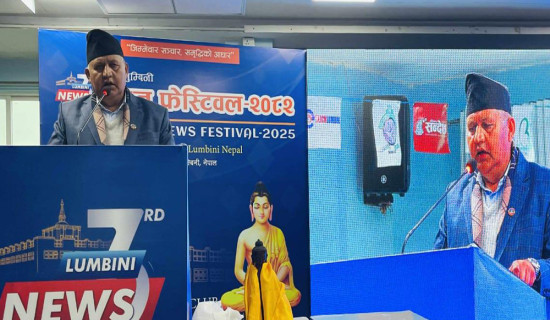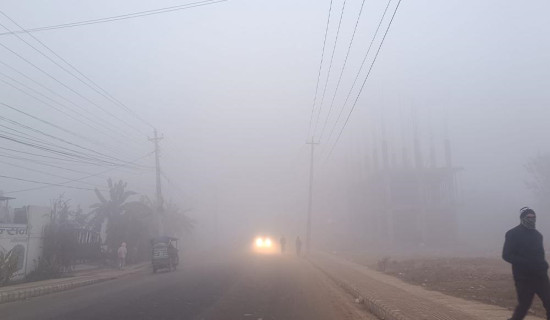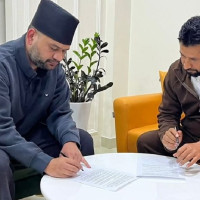- Sunday, 28 December 2025
Work underway to supply Melamchi water year-round
Melamchi, July 4: Progress has been made in the design work of the Melamchi Water Supply Project to provide water throughout the year.
Kamalraj Shrestha, the Project's Executive Director, stated that with the onset of the rainy season, the design works, including intake transfer and the sand silt system, have advanced through short-term solutions. As a result, water distribution for around 300 days (ten months) per year is now feasible.
Shrestha mentioned that the recovery process and the water diversion mechanism were obstructed by the devastating flood in the Melamchi River two years ago. He said, "Until the headwork is relocated using a medium-term solution, we are designing the project to bring water from the current location for twelve months."
Additional work needs to be done on the existing headwork structure to ensure a year-round water supply until the intake is permanently relocated to another site. The cost of moving the headwork is estimated to be between Rs. 80 million and 500 million, depending on weather conditions and study limits.
The Project plans to move the headwork to a location 300 to 400 meters above the current headwork.
Compared to the previous year, the river's water level has receded by six meters. However, experts believe that the likelihood of a similar flood occurring in Melamchi in the immediate future is very low, according to Shrestha.
He explained, "This season will have its ups and downs in water supply. Preparations have been made to close the intake when the river water is muddy and open it when the water is clear. “A favourable working environment will be created after August, enabling continuous water supply. Meanwhile, efforts are underway to relocate the headwork," Shrestha said.
Moving the headwork is estimated to cost more than Rs. 2 billion. Shrestha noted that while there is no 100 percent guarantee regarding the structure built in the river, it has been designed to withstand challenging conditions. Shrestha also mentioned that this season's rainfall is predicted to be below average, so there might not be heavy flooding in the river. The Project is currently monitoring the water supply and other risk factors.
He added, "We are also monitoring the water supply from the centre on a weekly basis. We reach the site once a week and there are other staff including engineers on the site as well."
Billions in losses from the flood
Under the Melamchi Water Supply Development Board, over Rs. 30.5 billion has been invested as of the last fiscal year. This amount includes expenses related to land acquisition of 1900 ropanis, social upliftment programmes, Environmental Impact Assessments (EIAs) at various stages, detailed design, and road access.
The Project Implementation Directorate has also spent a similar amount to provide water to every household from Sundarijal. Furthermore, approximately Rs. 1 billion was lost due to the flood two years ago, resulting in the destruction of the Melamchi estuary dam, intake structure, and headwork. On June 17, Prime Minister Pushpa Kamal Dahal 'Prachanda' inspected the road leading to the Melamchi estuary. He stated, "Currently, there is no road to reach the Melamchi estuary. Without access to the estuary, we cannot provide water for twelve months."
Prime Minister Prachanda observed the road and expressed his hope that the concerned authorities would initiate the process of constructing an access road. Once the road is accessible to the estuary, daily water supply will be facilitated.
The flood claimed the lives of 24 people in Helambu Rural Municipality, with two individuals still missing. Additionally, around 2100 ropanis of land, 20 trout farms, 380 houses, and agricultural land in Helambu were washed away.
Furthermore, 30 hectares of agricultural land in Indrawati Rural Municipality was destroyed. The flood also destroyed 273 houses, 3000 ropanis of land (both public and private), two motorable bridges, a suspension bridge, and a school in Melamchi Municipality. Additionally, four other suspension bridges were damaged in the municipality alone.
Study work underway
Hemant Kumar Sah, an engineer at the Project and site in-charge, recalled the past floods, describing the tremors and loud explosive sounds that accompanied them. Over the past two years, efforts have been made to study and observe the damaged structures.
After the flood destroyed all the structures, an alternative diversion was utilized to bring Melamchi water to Kathmandu. Other works, including construction of various gates and debris-clearing work, are underway.
Following the collapse of the previous structure, water enters the tunnel through Gate No. 9 and 38. Before being distributed to households in Kathmandu, the water undergoes treatment in Sundarijal. Four portals, Ambathan, Galthong, Sindhu, and Sundarijal, have been set up to manage the necessary systems for this purpose, according to Sah.
Designs for Yangri and Larke completes
The government has emphasised the careful implementation of the project to bring water from the Yangri and Larke rivers, in addition to the Melamchi River.
Estimates, documentation, and designs have been completed by engineers for this purpose. According to Er. Sah, the work on the Yangri and Larke rivers can be completed within the next three to four years, but further instructions from relevant stakeholders are awaited to proceed with the project.
Sah mentioned that the past floods alone caused some Rs. 2 billion in physical damage in Melamchi. An expert team from the Asian Development Bank (ADB) is conducting further studies on this project, funded by the bank.
The remaining work will be carried out after the preparation of report on whether to keep the Melamchi headwork in its original location or relocate it. Necessary measures have been taken to minimize potential damage during the rainy season.
Geologist Shiv Kumar Baskota remarked that landslides during the monsoon season have increased nearly threefold following the 2015 earthquake. He noted that Melamchi and other low-lying coastal areas are susceptible to the effects of climate change.
The increasing risk of glacier bursts and explosions is affecting both upper and lower regions. Thus, Baskota suggested taking necessary precautions against floods and landslides. Local representatives, including Helambu Rural Municipality, handed over a memorandum to the Prime Minister during his visit to the site.
During his visit, he emphasised timely completion of the drinking water project as a National Pride Project and pledged to provide necessary incentives to the people there. He acknowledged that resolving Kathmandu's water problem is a matter of great importance.







-square-thumb.jpg)








